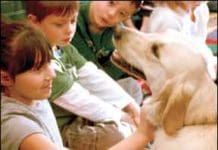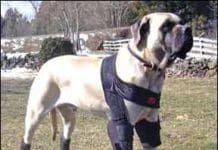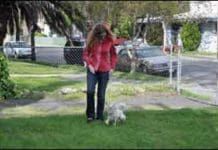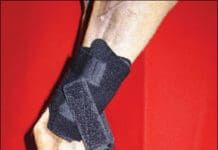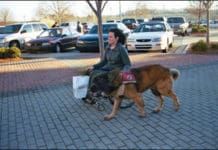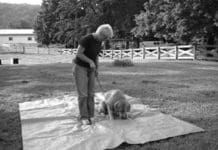Teach Your Dog to Help With Chores Around the House
Okay, I'll confess: I'm a lousy housekeeper. So when I first saw the YouTube videos starring Jessie the Jack Russell Terrier, who has been trained to do countless household chores, I found the idea of training my dogs to help me with the housework quite appealing.
Book Review: Training Your Diabetic Alert Dog
Training Your Diabetic Alert Dog is a clear, easy-to-read resource for anyone training a dog to alert to changes in blood glucose levels. It offers some general information, such as what it is like to live with a service dog, advice on choosing the right dog, and how to find a qualified trainer. The majority of the book, however, gives step-by-step training protocols with just the right amount of information. It was hard to put the book down; I found it very compelling. I wanted to know: How do you train for alerts? How does a dog learn to recognize the scent? What does the dog need to learn to be able to do night alerts or car alerts?
Diabetic Alert Dogs
Service dogs for people with diabetes are the “tattletales” of the dog world, according to Rita Martinez, co-author of a new book, Training Your Diabetic Alert Dog. The job for these special dogs is to notice a change in a person’s blood glucose level, and then tell that person about it. If that person doesn’t “listen” to the dog or isn’t able to respond, then a diabetic alert dog may tell someone else!
Orthopedic Equipment for Dogs that Increase Joint Support and Overall Mobility
In our March 2011 issue, we introduced you to a very small sampling of some of the neat “assistive equipment” options that are available to help our canine companions who have limited mobility or other physical issues. We received such a great response that we thought we’d share with you a few more finds that can help make life easier for you and your dog, particularly if he or she is aging or has orthopedic or neurologic issues. Remember: the products mentioned here are only the tip of the iceberg. There are numerous companies making innovative assistive products; what we’re hoping to do here is to get you thinking about some of the possibilities!
How to Train Hearing Impaired Dogs Using Hand Signals and Simple Gestures
I was recently contacted by a friend about a darling Border Collie puppy whose photo she found on Petfinder.com – and who was deaf. This friend is crazy about Border Collies, and also knows that I have a deaf Chinese Crested. Thus, she thought of me when she saw this puppy. The person who was fostering the pup was unable to keep her much longer, and did not want to send her to the local shelter as that would almost certainly result in the puppy’s euthanasia. Why? Because that shelter considers all deaf dogs as “unadoptable.”
Juneau’s Story – One of The Happiest Deaf Dogs You Could Ever Meet!
Juneau and I have learned a lot together. She came to me at 8 months of age as a well socialized puppy with tons of energy. If I didn’t find things for her to do, she’d find her own things to do. She may only be 12 inches tall, but she still figured out how to get things off of the counter (like an entire pizza).
Orthopedic Equipment for Dogs Designed for Increased Mobility and Extra Support
Do you have a dog recovering from orthopedic or neurologic surgery, one who has mobility issues, or a senior dog who has arthritis? If so, at some point, you have probably wished you could do something anything! to help make your dog's life (and your own) a little easier. I asked two veterinarians who specialize in canine rehabilitation to share some of their top picks for canine assistive/rehabilitative equipment. Laurie McCauley, DVM, CCRT, is founder and medical director of TOPS Veterinary Rehabilitation in Grayslake, Illinois, and is considered one of the pioneers in the field of veterinary rehabilitation. Evelyn Orenbuch, DVM, CAVCA, CCRT, recently opened Georgia Veterinary Rehabilitation, Fitness and Pain Management in Marietta, Georgia, and has focused on veterinary rehab medicine since 2003.
Has Your Senior Dog Started to Lose His Hearing?
If we're fortunate enough to have them live to old age, at some point, most of our canine companions begin to lose their hearing and may eventually be, for all intents and purposes, deaf. It's painful to watch a beloved dog become less and less responsive to his environment because he's unaware of what's going on around him, and even more so when it limits your ability to communicate with him. The thought of a hearing-impaired dog wandering off and not being able to hear your calls is frightening. Here are five things you can do if your dog's hearing isn't what it used to be.
Dog Carting and Draft Training
What do you envision when someone says “draft work“? What probably comes to mind are horses, mules, oxen, and other large “beasts of burden.” Think again. Since the 18th and 19th centuries, dogs have assisted humans by hauling wagons and carts across fields and through towns. Dogs have delivered milk and mail, hauled the day’s catch of fish from boat to town, and even hauled lumber in lumber camps. This heritage forms the basis upon which the sport of carting was built by a variety of breed clubs. Between the 1970s and 1990s interest in the sport grew; the St. Bernard folks offered their first competition in 1988, and Bernese Mountain Dog fans added theirs in 1991. The natural inclination of dogs to pull has been literally harnessed by a variety of people through the years. Put backward pressure on a leash and collar, and most dogs will pull forward. Take that “opposition reflex” and a nice, padded harness, and you can see where this is going. Forward, of course! Sledding. Weight pulling. Sulky driving. Skijoring. Carting. Some of these activities are still used to help humans with important tasks. Sled dogs have delivered critical medicines in the dead of winter. Service dogs pull wheelchairs. And some dogs show off their carting skills during public demonstrations and therapy dog visits. This sport has a very practical aspect to it. If you are creative, I’m sure there are tasks around home that you can find for your carting dog.
Dog Training With Hand Signals
as long as you are consistent.üThis is the gesture I use for cuing "Down!" It's a large signal that can be seen by a dog who is far away.üThis is the gesture I use for cuing "Sit!"I start with my arms at my sides
Assistance Dogs
Have you ever watched an assistance dog work? On the campus of the Virginia university where I attended graduate school, I often crossed paths with a student who used a wheelchair, accompanied by her assistance dog, a lovely Golden Retriever. They went to classes, visited the snack bars and cafeteria, hung out in the student lounges, and hoofed it all around campus together.









